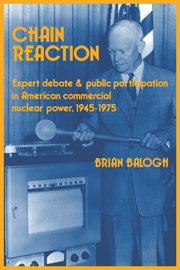 Chain Reaction
Chain Reaction Book contents
- Frontmatter
- Contents
- Acknowledgments
- List of abbreviations
- 1 From fission to fusion: professionalization and politics in twentieth-century America
- 2 The promise of the proministrative state: nuclear experts and national politics, 1945–1947
- 3 Forging an iron triangle: the politics of verisimilitude
- 4 Triangulating demand: the Atomic Energy Commission's first decade of commercialization
- 5 The centrifugal push of expertise: reactor safety, 1947–1960
- 6 The magnetic pull of professional disciplines, issue networks, and local government
- 7 Nuclear experts on top, not on tap: mainstreaming expertise, 1957–1970
- 8 Nuclear experts everywhere: the challenge to nuclear power, 1960–1975
- 9 Conclusion: harnessing political chain reactions
- Index
7 - Nuclear experts on top, not on tap: mainstreaming expertise, 1957–1970
Published online by Cambridge University Press: 07 May 2010
- Frontmatter
- Contents
- Acknowledgments
- List of abbreviations
- 1 From fission to fusion: professionalization and politics in twentieth-century America
- 2 The promise of the proministrative state: nuclear experts and national politics, 1945–1947
- 3 Forging an iron triangle: the politics of verisimilitude
- 4 Triangulating demand: the Atomic Energy Commission's first decade of commercialization
- 5 The centrifugal push of expertise: reactor safety, 1947–1960
- 6 The magnetic pull of professional disciplines, issue networks, and local government
- 7 Nuclear experts on top, not on tap: mainstreaming expertise, 1957–1970
- 8 Nuclear experts everywhere: the challenge to nuclear power, 1960–1975
- 9 Conclusion: harnessing political chain reactions
- Index
Summary
It took more than the occasional public glimpse of expert debate, controversy, and overconfidence, if not dissembling, to shake America's faith in its experts. The cumulative impact of the most publicized controversies in the late 1950s and early 1960s – such as the health effects of fallout, the damage caused by thalidomide, the benefits and risks associated with fluoridation, not to mention far more obscure bouts between experts such as the PRDC controversy – were overshadowed by one event in early October 1957: Sputnik. Coming on the heels of a decade of military accomplishments that suggested the Soviet Union was catching up to American achievements, Soviet capacity to launch a satellite into orbit was interpreted by millions – including a broad spectrum of policymakers – as proof that the Soviets had finally surpassed America in the race for scientific and technological superiority.
Sputnik was the perfect symbol of a cold war that could be won only if the nation mobilized fully all of its resources. Militarily, America's top defense personnel explained, Sputnik did not prove anything. It was passive and primitive. Or as Strategic Air Commander Curtis LeMay explained, “It's just a hunk of iron.” Diplomatically, the Eisenhower administration first tried to shrug off the implications of the Soviet space shot. It was not the policy of the United States, Eisenhower aide Sherman Adams told the press, to accumulate the “high score in a celestial basketball game.”
- Type
- Chapter
- Information
- Chain ReactionExpert Debate and Public Participation in American Commercial Nuclear Power 1945–1975, pp. 171 - 220Publisher: Cambridge University PressPrint publication year: 1991


